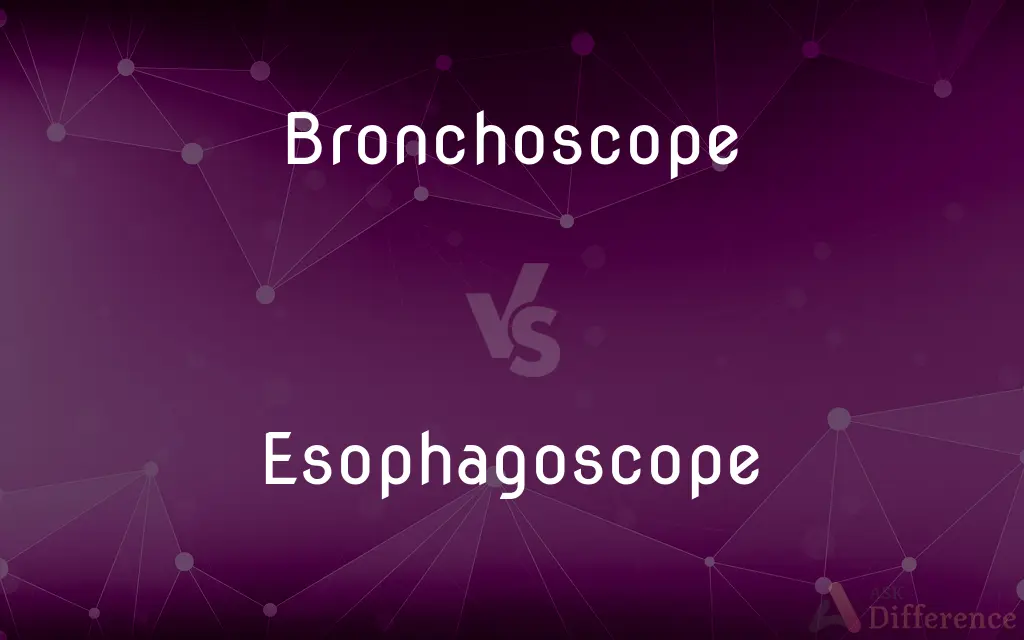Bronchoscope vs. Esophagoscope — What's the Difference?
By Urooj Arif & Fiza Rafique — Updated on March 26, 2024
A bronchoscope is used to view the airways and lungs, while an esophagoscope examines the esophagus, each targeting different parts of the body for diagnosis and treatment.

Difference Between Bronchoscope and Esophagoscope
Table of Contents
ADVERTISEMENT
Key Differences
Bronchoscopes are medical devices designed for the visual examination, biopsy, and treatment of the bronchial tubes and lungs. They are essential tools in diagnosing and managing respiratory diseases. Esophagoscopes, on the other hand, are used to inspect, diagnose, and treat conditions affecting the esophagus, the tube that carries food from the mouth to the stomach.
While both devices are endoscopic tools inserted into the body, their designs reflect their specific uses. A bronchoscope is typically flexible to navigate the complex bronchial pathways, whereas esophagoscopes can be rigid or flexible, depending on the procedure's requirements.
The primary function of a bronchoscope is to investigate symptoms like persistent cough, infection, or to remove foreign objects from the airways. Esophagoscopes are used to examine symptoms like difficulty swallowing, esophageal pain, or to remove foreign objects from the esophagus.
Both procedures require a skilled specialist: a pulmonologist or respiratory therapist may operate a bronchoscope, while an esophagoscope is typically used by a gastroenterologist or a surgeon specializing in the esophagus.
Comparison Chart
Purpose
Examines the bronchial tubes and lungs.
Examines the esophagus.
ADVERTISEMENT
Design
Flexible to navigate bronchial pathways.
Can be rigid or flexible for esophageal inspection.
Primary Use
Diagnosing respiratory diseases, removing foreign objects.
Investigating swallowing difficulties, esophageal disorders.
Operated By
Pulmonologists, respiratory therapists.
Gastroenterologists, surgeons.
Types of Procedures
Biopsy, foreign object removal, infection investigation.
Foreign object removal, biopsy, investigation of pain.
Compare with Definitions
Bronchoscope
Flexible, equipped with a light and camera to navigate the bronchial tubes.
The flexibility of the bronchoscope allows for a thorough examination of the airways.
Esophagoscope
A device designed for the visual inspection of the esophagus.
The esophagoscope revealed the cause of his difficulty swallowing.
Bronchoscope
Can perform biopsies, foreign object retrieval, and visualize infections.
During the procedure, the bronchoscope was used to take tissue samples for biopsy.
Esophagoscope
Used to diagnose and treat esophageal conditions such as strictures or tumors.
An esophagoscope was employed to remove a foreign object from the esophagus.
Bronchoscope
A medical device used to examine the airways and lungs.
The doctor used a bronchoscope to identify the cause of his persistent cough.
Esophagoscope
Available in rigid and flexible forms to suit different diagnostic needs.
The surgeon chose a rigid esophagoscope for the procedure for better precision.
Bronchoscope
Essential for diagnosing lung diseases, infections, or removing obstructions.
A bronchoscope was utilized to remove the small object lodged in her airway.
Esophagoscope
Enables biopsy, removal of foreign objects, and examination of esophageal lining.
The procedure involved using an esophagoscope to assess the esophageal tissue health.
Bronchoscope
Operated by pulmonologists or respiratory therapists.
The pulmonologist expertly maneuvered the bronchoscope to inspect the lungs.
Esophagoscope
Typically used by gastroenterologists or specialized surgeons.
The gastroenterologist used an esophagoscope to investigate esophageal pain.
Bronchoscope
A slender tubular instrument with a small light on the end for inspection of the interior of the bronchi.
Esophagoscope
(American spelling) A form of endoscope for inspecting the esophagus.
Bronchoscope
A form of endoscope for inspecting the bronchial tubes
Esophagoscope
An optical instrument for examining the inside of the esophagus
Bronchoscope
A slender tubular instrument used to examine the bronchial tubes
Common Curiosities
What is a bronchoscope used for?
A bronchoscope is used for examining, diagnosing, and treating conditions related to the airways and lungs.
Are there risks associated with using a bronchoscope or esophagoscope?
As with any medical procedure, there are risks, including discomfort, infection, or damage to the area being examined. However, these procedures are generally safe when performed by qualified professionals.
What is an esophagoscope?
An esophagoscope is a medical device for inspecting and treating conditions of the esophagus.
What advancements have been made in bronchoscopy and esophagoscopy?
Technological advancements include improved imaging, the ability to perform more complex procedures with minimal discomfort, and enhanced safety features.
How do doctors decide whether to use a bronchoscope or an esophagoscope?
The choice depends on the patient's symptoms and the specific area needing examination or treatment, based on whether the concern lies within the respiratory system or the esophagus.
Is sedation required for bronchoscopy or esophagoscopy?
Sedation is commonly used to ensure the comfort and safety of the patient during these procedures.
Can bronchoscopes and esophagoscopes detect cancer?
Yes, both devices can be used to take tissue biopsies for cancer diagnosis.
What is the difference between a rigid and a flexible esophagoscope?
Rigid esophagoscopes offer more precision for certain procedures, while flexible esophagoscopes are better for navigating and examining the entire esophagus.
Can a bronchoscope be used to examine the esophagus?
While bronchoscopes are primarily for lung and airway examination, some procedures might incidentally involve esophageal inspection. However, esophagoscopes are specialized for detailed esophageal examination.
Are these procedures painful?
Discomfort is minimized through the use of local anesthesia and sedation, making the procedures tolerable.
Can these procedures be done on children?
Yes, both procedures can be adapted for children, with careful consideration of the device size and the specific pediatric condition being addressed.
Can bronchoscopes and esophagoscopes treat conditions, or are they just for diagnosis?
In addition to diagnosis, these tools can also perform treatments such as removing foreign objects, applying medication, or performing minor surgeries.
How often should these procedures be performed?
The frequency depends on the individual's medical condition, the results of initial examinations, and ongoing monitoring requirements.
How do patients prepare for a bronchoscopy or esophagoscopy?
Preparation might include fasting, avoiding certain medications, and arranging for someone to drive them home afterward, depending on the specifics of the procedure.
How long does recovery take after these procedures?
Recovery times can vary, but most patients can resume normal activities within a day, although they might experience throat soreness or coughing.
Share Your Discovery

Previous Comparison
Validate vs. Verify
Next Comparison
Study vs. LearnAuthor Spotlight
Written by
Urooj ArifUrooj is a skilled content writer at Ask Difference, known for her exceptional ability to simplify complex topics into engaging and informative content. With a passion for research and a flair for clear, concise writing, she consistently delivers articles that resonate with our diverse audience.
Co-written by
Fiza RafiqueFiza Rafique is a skilled content writer at AskDifference.com, where she meticulously refines and enhances written pieces. Drawing from her vast editorial expertise, Fiza ensures clarity, accuracy, and precision in every article. Passionate about language, she continually seeks to elevate the quality of content for readers worldwide.
















































